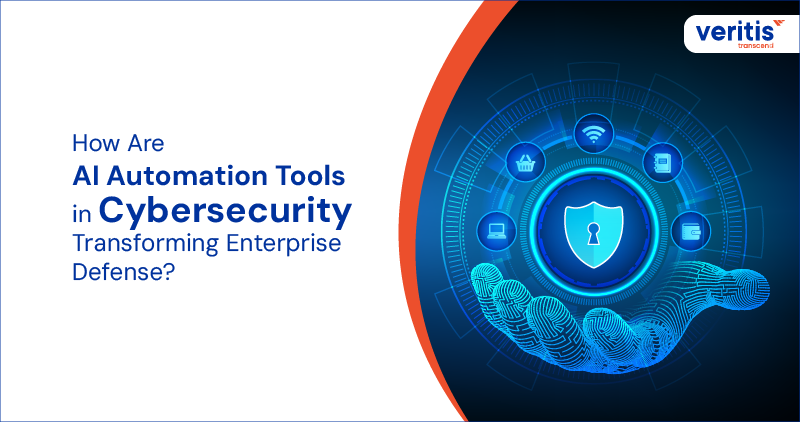
When contemplating security automation, many in the cybersecurity sector immediately associate it with automated response mechanisms. However, it’s key to recognize that automating response actions represents only a portion of the value of cybersecurity automation and is a relatively more superficial aspect to develop.
The more intricate challenge lies in efficiently processing vast quantities of data from diverse sources, correlating, enriching, aggregating, and precisely analyzing it. The ultimate goal is to present this information in a format conducive to real time human decision making. This facet of cybersecurity automation has been a focal point for nearly a decade, presenting a complex problem space that can benefit significantly from integrating AI automation tools.
In modern cybersecurity automation software, the focus is shifting toward leveraging AI automation and data security strategies that improve visibility, speed, and accuracy. Tools that integrate AI and security automation are redefining the operational tempo of cyber defense.
In security operations, it’s universally recognized that there’s no single panacea or rapid solution. Combining artificial intelligence security tools and cyber security automation tools presents significant potential, providing teams with enhanced contextual understanding, better signal clarity amidst noise, and quicker response capabilities.
These technologies entail delegating traditionally human performed tasks to computational systems. While automation in cyber security is often better understood than that of AI, it serves as a foundational framework for delineating the application of AI within Security Operations (SecOps). The imperative to define the roles of AI and automation stems from AI’s disruptive potential within the cybersecurity era, particularly in areas such as AI automation in cybersecurity and IT security automation, where emerging cybersecurity automation tools continue to expand operational efficiency and decision intelligence.
It’s universally recognized that there is no single panacea or rapid solution in security operations. Combining artificial intelligence (AI) and security automation offers significant potential, providing teams with enhanced contextual understanding, clearer signals amid noise, and faster response times. Adopting an AIOps strategy within security operations helps organizations streamline processes, improve automation, and detect and resolve issues proactively.
Talk To Our AI Automation Expert
The Impact of AI on Cybercrime and Cyberdefense

Given the rising prevalence of Artificial Intelligence in cybersecurity over recent months and years, and its anticipated dominance as a disruptor despite growing regulatory oversight, the cyber threat field is evolving rapidly. As AI automation in cybersecurity becomes increasingly common, the lines between defense and offense continue to blur.
While AI offers vast opportunities to automate operations with leading AI tools for business, it also empowers cybercriminals to innovate and refine their attack strategies. The misuse of AI automation tools introduces new layers of complexity in identifying and responding to threats, emphasizing the need for secure and ethical implementation.
Despite AI’s promise in accelerating workflows, cybersecurity automation specialists stress the importance of prudent deployment, particularly in areas including incident response and penetration testing. These still demand human judgment to ensure precision and mitigate the risk of false positives, a challenge that even advanced AI security automation systems face.
To remain resilient, businesses must adopt AI automation tools in cybersecurity as part of broader cyber security automation tools integration. This involves not automating detection and response through security automation tools, but also deploying AI productivity tools to streamline processes and improve signal to noise ratios in security alerts.
However, successful implementation of automation in cyber security calls for strategic foresight, sustained investment, and deep technical expertise. With the growing risk of automated cybersecurity threats, the cost of cybercrime could rise exponentially if defenses aren’t modernized through IT security automation and cybersecurity automation tools.
Therefore, organizations must assess the long term implications of cybersecurity automation software and the malicious use of artificial intelligence security tools by adversaries. Proactively exploring automation in cybersecurity not only strengthens digital defenses but also prepares businesses for a future where AI is embedded in both attack and defense mechanisms.
The Rising Cost of Cybercrime
Cybercrime presents a pervasive marketplace for threat actors, with risk mitigation and defense costs steadily escalating annually.
Projections indicate that global cybercrime expenses will reach USD 10.5 trillion annually by 2025, a significant increase from USD 3 trillion in 2015.
Several contributing factors drive this exponential increase:
- Expanded Online Business Operations: The proliferation of online business activities has significantly enlarged the attack surface, providing cybercriminals with ample opportunities.
- Advancements in Attack Sophistication: Cybercriminal syndicates employ sophisticated tactics and leverage advanced technologies like AI to orchestrate covert and prolonged assaults, resulting in sustained damage to systems and infrastructure.
- The Proliferation of Connected Devices: The surge in connected devices, encompassing IoT devices, cloud-based storage systems, and servers, amplifies the potential entry points available for exploitation by threat actors.
- Increased Data Value: Data has become a lucrative target for malicious hacking. Sensitive information such as medical records, financial data, and intellectual property can be leveraged for ransom demands or sold on underground markets.
- Lucrativeness of Ransomware: Ransomware attacks have emerged as highly profitable ventures for cybercriminals. They enable them to extort substantial sums from victims reluctant to have sensitive information leaked.
AI further empowers cybercriminals, so brands must adopt proactive measures beyond conventional malware detection software to ensure robust security.
Useful Link: Strengthening Digital Well-being: A Cybersecurity Transformation for Fitness and Wellness Platform
How Attackers Use AI
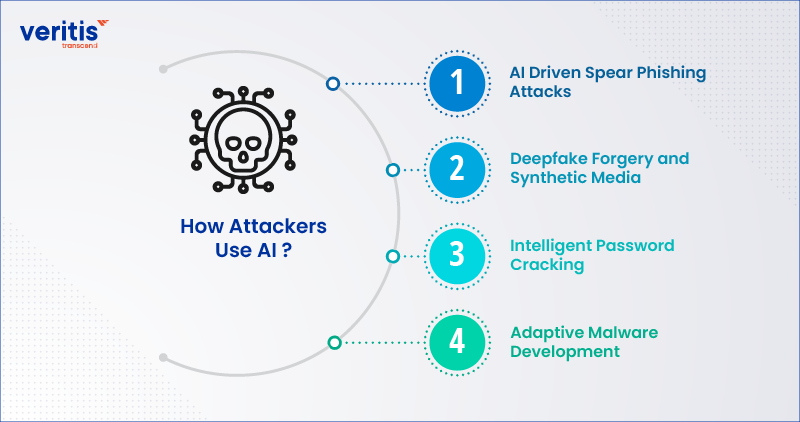
To build resilient defenses, enterprises must first understand how cybercriminals leverage AI automation tools in cybersecurity. These attackers now operate with algorithmically powered systems, capable of rapid infiltration, evasion, and manipulation, often without human intervention. Below are four key ways adversaries exploit AI automation in cybersecurity:
Here are several methodologies through which attackers exploit AI:
1) AI Driven Spear Phishing Attacks
Cybercriminals use AI security automation to craft hyper personalized phishing emails by mimicking writing styles, tone, and known contacts. These messages trigger immediate responses, bypassing human scrutiny and increasing breach success rates.
2) Deepfake Forgery and Synthetic Media
Attackers leverage artificial intelligence security tools to create convincing fake audio, video, and documents. These deepfakes can authorize fraudulent transactions, manipulate executives, or compromise internal trust, challenging traditional verification systems.
3) Intelligent Password Cracking
Using automated cybersecurity techniques, attackers deploy AI to prioritize the most likely password combinations, informed by behavioral data and leaked credentials. Without IT security automation or strong MFA, organizations are exposed to high breach risks.
4) Adaptive Malware Development
AI enables polymorphic malware, code that evolves continuously to avoid detection. Cyber security automation tools help attackers generate multiple variants in real time, rendering legacy antivirus tools ineffective. This rapid iteration accelerates deployment and impact.
The rise of cybersecurity automation is not exclusive to defenders. Attackers now exploit the same technologies to operate at scale. However, organizations can counteract this threat with advanced cybersecurity automation tools, AI automation, and data security platforms, as well as intelligent response strategies.
By investing in automation in cybersecurity, enterprises can strengthen detection, reduce response time, and future proof their digital ecosystems.
Useful Link: AI and Cybersecurity: Defending Against Evolving Threats
Use AI for Cyber Defense in Business Operations
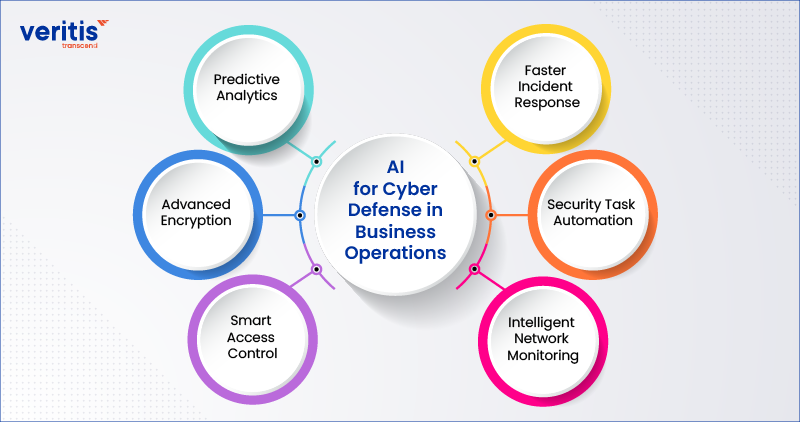
Enterprises are increasingly adopting AI automation in cybersecurity to fortify defenses, reduce manual workloads, and gain a proactive edge against evolving threats. By combining AI automation tools with advanced cybersecurity automation software, organizations can move from reactive to predictive defense strategies.
1) Predictive Analytics
AI automation tools in cybersecurity analyze vast datasets to detect vulnerabilities early, enabling proactive patching and risk mitigation. This form of automation in cyber security minimizes downtime, prevents breaches, and enhances resilience.
2) Advanced Encryption
AI strengthens cyber security automation with adaptive encryption and streamlined MFA systems such as OTPs and biometrics. These artificial intelligence security tools ensure sensitive data stays protected even against advanced attack vectors.
3) Smart Access Control
Cybersecurity automation tools enhance identity management with real time validation through biometrics and behavior analytics. By detecting credential misuse, AI security automation reduces insider threats and prevents unauthorized access.
4) Intelligent Network Monitoring
AI algorithms continuously monitor traffic, detecting anomalies like DDoS or malware infiltration. With automated cybersecurity and real time alerts, enterprises can accelerate investigation and containment, which are key benefits of automation in cybersecurity.
5) Security Task Automation
Security automation tools streamline repetitive SOC tasks, reducing alert fatigue and human error. Integrated with IT security automation, these systems improve detection accuracy and operational efficiency without compromising compliance.
6) Faster Incident Response
AI powered cyber security automation tools analyze threats in real time and recommend optimal actions. This accelerates incident response, shortens breach resolution time, and protects business continuity with cybersecurity automation software.
Integrating cybersecurity automation tools, AI automation and data security, and AI automation in cybersecurity is key for enterprises. By leveraging AI security automation across predictive analytics, monitoring, and incident response, businesses can defend at machine speed and stay ahead of attackers.
Useful Link: Cybersecurity Best Practices: Protecting Your Business from Data Breaches
Benefits of AI in Cyber Security Testing
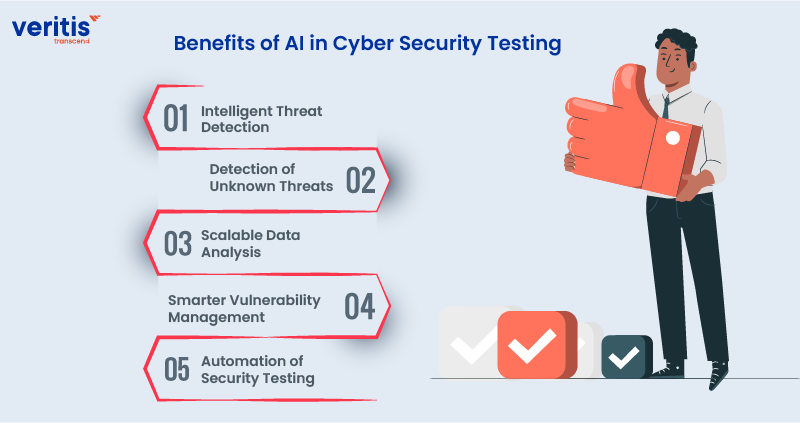
AI in cybersecurity testing delivers intelligent automation, faster threat detection, and scalable analysis, helping organizations strengthen defenses while reducing manual workloads. By leveraging AI automation tools in cybersecurity, enterprises can modernize defenses, improve resilience, and future proof operations.
Additionally, AIOps services offer the advantage of swiftly and accurately identifying malicious threats. Organizations can preemptively detect potential attacks using AI-powered solutions and implement appropriate measures to mitigate risks before they materialize.
1) Intelligent Threat Detection
A) Behavioral Pattern Recognition
AI powered cybersecurity automation tools learn normal network behavior, detect anomalies in real time, and flag deviations for immediate action. This advanced AI security automation improves early stage threat visibility.
B) Real Time Response
With automated cybersecurity, AI tools analyze traffic instantly and respond autonomously to irregularities, reducing response lag and ensuring continuous protection.
2) Detection of Unknown Threats
A) Zero Day Attack Identification
Artificial intelligence security tools excel at detecting novel threats that traditional systems miss, including zero day vulnerabilities, malware mutations, and advanced phishing campaigns.
B) Proactive Defense
By integrating AI automation in cybersecurity, organizations can take preventive measures before attackers exploit vulnerabilities, ensuring a proactive security stance.
3) Scalable Data Analysis
A) Massive Data Processing
AI driven cyber security automation tools process vast datasets and network logs at machine speed, uncovering hidden threats within routine activity.
B) Proxy Integration
Residential proxies combined with AI automation tools enhance secure data transfer, traffic analysis, and privacy protection at enterprise scale.
4) Smarter Vulnerability Management
A) Prioritization of Risks
AI solutions in IT security automation rank vulnerabilities by severity and exploitability, helping security teams focus on high risk issues first.
B) Faster Mitigation
With cybersecurity automation software, teams act promptly, closing exposure windows and ensuring patches are applied on time.
5) Automation of Security Testing
A) Workflow Efficiency
Security automation tools streamline penetration testing, red teaming, and compliance scans, freeing resources for strategic initiatives.
B) Continuous Monitoring
AI enabled automation in cyber security delivers continuous assessments and alerts, supporting compliance readiness and operational resilience.
Adopting AI automation and data security solutions in cybersecurity testing is not optional. With cybersecurity automation tools and AI automation tools, enterprises can reduce risks, scale defenses intelligently, and gain real time visibility, empowering them to defend at machine speed and stay ahead of attackers.
Disadvantages of AI in Cybersecurity
While emerging technologies, such as AI, offer considerable benefits, they also present inherent risks. It’s crucial to acknowledge the potential downsides associated with the widespread of AI adoption, which include:
- Offensive AI and ethical dilemmas
- Concerns regarding data privacy
- AI induced biases in programming, training, and maintenance
- Transparency issues
- Potential misuse and exploitation
- Challenges in compliance with regulations
Useful Link: DevSecOps – The DevOps Answer to Cybersecurity Challenges
8 Best Cybersecurity Automation Tools for Enterprise Grade Protection
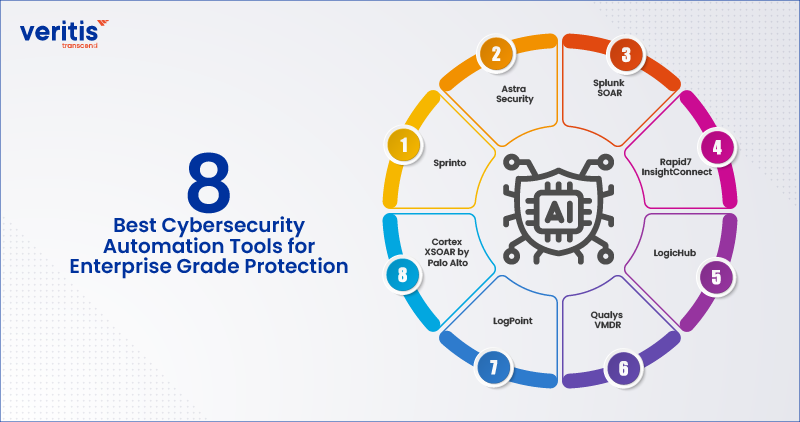
In the AI world, cybersecurity leaders must prioritize automated, scalable, and intelligence powered solutions to secure digital infrastructure. Below are 8 top cybersecurity automation tools that empower organizations to streamline response, ensure compliance, and protect proactively.
1) Sprinto: Compliance Automation at Scale
Sprinto automates security compliance workflows (SOC 2, ISO 27001, GDPR) and risk assessments across cloud environments. Ideal for fast scaling enterprises seeking audit readiness with minimal manual effort.
2) Astra Security: AI Powered Web App Security
Astra offers complete protection for web applications through automated vulnerability scanning, pentesting, and firewall deployment, backed by real time threat monitoring and AI based alerting.
3) Splunk SOAR: Orchestrated Response, Elevated Resilience
Splunk SOAR (Security Orchestration, Automation, and Response) enables teams to automate complex workflows, reduce response times, and integrate across the entire SOC toolchain.
4) Rapid7 InsightConnect: Automated Incident Handling with Context
Part of the Rapid7 Insight platform, InsightConnect streamlines repetitive tasks like threat enrichment, containment, and user deprovisioning, boosting SOC efficiency while maintaining context and control.
5) LogicHub: Adaptive Security Automation and Decision Making
LogicHub combines automation with intelligent decision making to reduce alert fatigue. Its SOAR platform learns analyst behavior to improve detection accuracy over time.
6) Qualys VMDR: Continuous Vulnerability Management and Remediation
VMDR (Vulnerability Management, Detection, and Response) offers a unified dashboard for asset inventory, threat prioritization, and patch automation, ideal for large enterprise environments.
7) LogPoint : SIEM with Native Automation Capabilities
LogPoint blends SIEM and SOAR, providing real time threat analytics, incident automation, and compliance reporting, enhancing visibility and speed across hybrid IT infrastructures.
8) Cortex XSOAR by Palo Alto: Enterprise Grade Threat Response Platform
A market leader in SOAR, Cortex XSOAR integrates case management, threat intel, playbooks, and real time collaboration, empowering security teams to automate at scale and act decisively.
Investing in cybersecurity automation tools is foundational. From compliance and threat detection to incident response and remediation, these platforms enable C-suite leaders to reduce risk exposure, optimize security operations, and ensure business continuity in an AI world.
Need help selecting the right solution?
Veritis partners with enterprises to design, deploy, and manage AI driven cybersecurity automation strategies tailored to industry, scale, and risk posture.
AI Based Security Testing Services

The market offers numerous AI-based security testing solutions, some of which are highly regarded:
1) Intrusion Detection Systems (IDS)
Utilizing AI algorithms, IDS detects and responds to suspicious activities within a network, enhancing security posture.
2) Vulnerability Management Systems (VMS)
AI-driven VMS evaluates network vulnerabilities, employing algorithms to scan for weaknesses and recommend mitigation strategies.
3) Behavioral Analytics
The AI systems observe and analyze user behavior to identify indications of malicious activity, enhancing the capabilities for detecting threats.
4) Security Auditing Systems
AI-powered auditing systems assess organizational security postures by analyzing networks’ weaknesses and vulnerabilities.
These solutions represent a fraction of the AI-based security testing offerings available. By leveraging such technologies, organizations can better understand their AI and cybersecurity domain and mitigate the risk of cyberattacks more effectively.
Optimizing AI for Your Cybersecurity Testing
Understanding the diverse range of AI-based security testing solutions is paramount to harnessing AI effectively in cybersecurity testing. Once you grasp these solutions, you can evaluate which best meets your security requirements.
During the evaluation process, several critical factors warrant consideration:
- Cost: Assess the expenses of implementing and maintaining AI security testing solutions.
- Scalability: Evaluate the scalability potential of the chosen AI security testing solution.
- Accuracy: Determine the accuracy levels of the AI security testing solution.
- Ease of Use: Gauge the user friendliness of the AI security testing solution.
By scrutinizing these factors, you can pinpoint the AI security testing solution that optimally suits your cybersecurity needs.
Case Study: Strengthening E-commerce Resilience with AI-Driven Incident Management
An e-commerce company partnered with Veritis to enhance its digital platform’s reliability and security through AI-powered incident response.
Challenge: The business experienced frequent service interruptions and lacked the speed and accuracy to detect and respond to emerging threats in real time.
Solution: Veritis implemented an advanced AIOps solution powered by AI and automation to continuously monitor systems, detect anomalies early, and automate incident resolution, thereby reducing risk exposure.
Results:
- 70% faster response to IT incidents and anomalies
- Improved platform stability and threat detection
- Reduced manual workload through automated cybersecurity operations
This transformation underscores how AI and automation can enhance cybersecurity postures, providing predictive capabilities and faster responses that are crucial for safeguarding today’s digital environments.
Read the Full Case Study: Revolutionizing Incident Management With AIOps in E-commerce Platform
Conclusion
AI powered security testing has become key for modern cybersecurity. It enables faster threat detection, real time analysis, and automated testing, helping organizations stay proactive, efficient, and secure. When selecting a solution, focus on accuracy, scalability, cost effectiveness, and ease of deployment. Continuous testing and updates are critical to maintaining a robust defense. Veritis, a multiple Stevie and Globee award winner, delivers the following gen AI cybersecurity solutions tailored to your enterprise needs.
Stay ahead of threats by partnering with Veritis for intelligent, future ready security.
Looking for Support? Schedule A Call
Also Read:
- 7 Essential AI Tools Every CTO Should Be Familiar With
- What is Generative AI: An Ultimate Guide to Amazon Generative AI Tools
- AIOps Vs MLOps: Understanding Significant Differences
- A Guide to APIOps, the Collaborative Approach for API Production
- AIOps Use Cases: How Artificial Intelligence is Reshaping IT Management
- All You Need to Know about Artificial Intelligence as a Service (AIaaS)